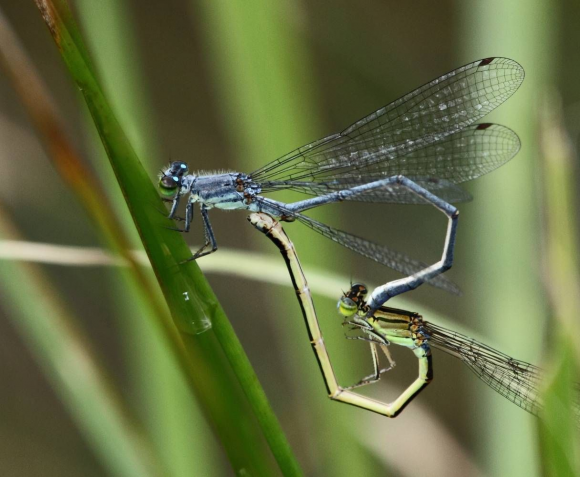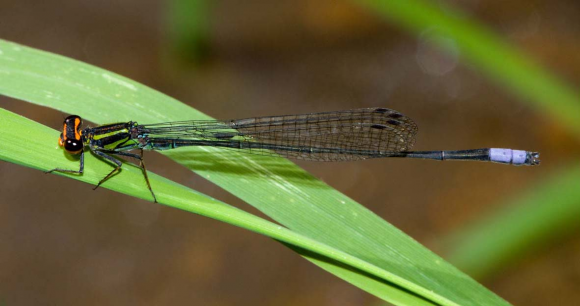Genus Pseudagrion Selys, (A–group)
A-sprites
Type species: Agrion furcigerum Rambur, 1842
Introduction
The A-group species of Pseudagrion are mainly slender, fairly small to fairly large (hindwing 17-29 mm), black damselflies with colourful accents on head, thorax and abdominal segments 7-10. They favour relatively cool habitats, e.g. shaded, running and/or elevated, those species inhabiting more open habitats tending to become densely pruinose. Most pruinose and widespread is P. kersteni, which may occur at almost any open stream in tropical Africa. Many species are associated with the highlands of eastern and southern Africa, of which P. spernatum is most characteristic and widespread, found at grassy borders of open streams and rivers. More restricted in similar habitat are P. kaffinum (Ethiopia), P. munte and P. symoensii (both Katanga) P. vumbaense (Zimbabwe) and P. risi (Cameroon highlands). Other localised highland species prefer forested streams: P. angolense (Angola), P. rufocinctum (Albertine Rift), P. guichardi (Ethiopia), and P. bicoerulans (Mts Elgon, Kenya, Kilimanjaro and some others nearby). Six species are confined to South Africa: P. caffrum and P. furcigerum occur on smaller streams in the highveld and Cape respectively, while P. citricola and P. draconis favour larger streams and rivers and are more widespread. P. inopinatum and P. newtoni both occur at only a handful of swift rivers with grassy banks in north-eastern South Africa. The ranges of P. salisburyense (pools and slow streams, often shaded, but sometimes open rivers), P. gamblesi (rather open streams and rivers) and P. hageni (streams in or near forest and woodland) also coincide with the upland areas from Ethiopia to South Africa, but their association with highlands is less strict.
Six species are localised in streams or marsh in the triangle from Angola, north-eastern South Africa to northern Malawi, centred on northern Zambia: some more in shade (P. coeruleipunctum, P. fisheri) and others in the open (P. greeni, P. inconspicuum, P. makabusiense, P. sarepi). In the forested region from western Kenya and northern Zambia to western Africa P. melanicterum is found at any stream with some cover and not too deep shade, as well as P. kibalense on streams with proper forest; P. serrulatum is localised at larger forest streams in Central Africa, while P. epiphonematicum, P. grilloti and probably P. spinithoracicum occur at smaller streams deep in forest. P. estesi and P. simonae occur alongside P. melanicterum and P. kibalense in Angola (P. simonae extends to southern Gabon). P. bernardi is confined to clear sandy rivers in grassland enclosed by forest in Gabon and the Congos. P. aguessei and P. emarginatum are localised at streams and P. gigas probably at rivers in the wooded savanna north of equatorial Africa. Six notably slender species belong to a rather distinctive subgroup of six central and western African forest species. All habitually hang off the tip of leaves like Allocnemis species, rather than perching with the body more-or-less parallel above the substrate as other Pseudagrion: the larger blue species P. malagasoides is found in undergrowth of forest flooded by streams or rivers, the smaller blue P. cyathiforme and P. simplicilaminatum on larger sandy streams, and the orange P. dactylidium, P. hemicolon and P. thenartum at small muddy streams, seeps and pools. Nothing is known of P. mascagnii described from near Freetown in Sierra Leone.
Identification should rely on mature, fully-coloured specimens. Appendages are essential for identification, but their shape is difficult to describe. The cerci typically have a lower and upper branch with a mouth-like gap between them (lateral view). The inner side of the ventral border of the lower branch is often expanded into a ridge- or wing-like flange, which at its basal end may be developed into a marked angle or tooth (dorsal view). Separate from this (placed more basally and dorsally on inside of cerci) there may also be a basal tooth (dorsal view). [Adapted from Dijkstra & Clausnitzer 2014]
Diagnosis
Male of group similar to Pseudagrion B (a) relatively small in size, Hw under 35 mm, Abd under 40 mm; (b) postocular spots often present; (c) transverse ridge on frons absent and Abd never with orange or red, but often with blue; (d) black markings usually more extensive, humeral stripe usually present, if absent body often with blue; (e) Fw quadrilateral with anterior border clearly shorter than distal border; (f) arculus stands at or closer to Ax2. However, differs by (1) metapleural suture often with black stripe, rather than black dot at dorsal end; (2) S8-9 often at least laterally marked with black; (3) apex of S10 widely and smoothly excised, rather than narrow excision; (4) apex of S10 without black denticles, but may have lobes; (5) cerci usually with two distinct branches and paraprocts often pointed but without spine or inferior bulge (lateral view). [Adapted from Dijkstra & Clausnitzer 2014; this diagnosis not yet verified by author]

Pseudagrion (A) inopinatum Balinsky, 1971. Male&female © Alan Manson

Pseudagrion (A) hageni Karsch, 1893. Male © Adolfo Cordero
Map citation: Clausnitzer, V., K.-D.B. Dijkstra, R. Koch, J.-P. Boudot, W.R.T. Darwall, J. Kipping, B. Samraoui, M.J. Samways, J.P. Simaika & F. Suhling, 2012. Focus on African Freshwaters: hotspots of dragonfly diversity and conservation concern. Frontiers in Ecology and the Environment 10: 129-134.
Citation: Dijkstra, K.-D.B (editor). African Dragonflies and Damselflies Online. http://addo.adu.org.za/ [2024-07-27].

